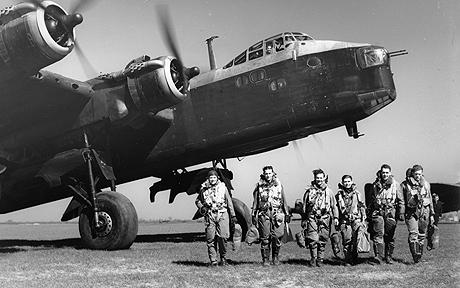The 90 Sqdn left from Wratting Common at 1943-11-26 at 17:02. Loc or duty Gardening
He flew with a Short Stirling (type III, serial EF511, code WP-C).
Campaign report of the USAAF:
STRATEGIC OPERATIONS
(Eighth Air Force): VIII Bomber Command Mission 138: Bremen, Germany and Paris, France are targetted.
1. 350 of 390 B-17's, 77 of 101 B-24's and 13 of 14 B-17 PFF aircraft attack the port area of Bremen at 1145-1228 hours; they claim 16-3-10 Luftwaffe aircraft; 22 B-17's and 3 B-24's are lost; 3 B-17's and 1 B-24 are damaged beyond repair and 139 B-17's, 19 B-24's and 7 PFF B-17's are damaged; casualties are 10 KIA, 35 WIA and 215 MIA.
2. 128 B-17's are dispatched to Paris but they abort the mission on arrival over the target because of complete cloud cover which totally obscures the objective; they claim 8-2-3 Luftwaffe aircraft; 4 B-17's are lost and 18 damaged; casualties are 3 WIA and 40 MIA. These missions are escorted by 28 P-38's and 353 P-47's; they claim 36-3-9 Luftwaffe aircraft; 4 P-47's are lost, 3 damaged beyond repair and 7 damaged; casualties are 4 MIA.
TACTICAL OPERATIONS
(Ninth Air Force): In France, almost 140 B-26's attack Cambrai/Epinoy and Roye/Amy airfields and military construction in the town of Audinghen.
Campaign report of the RAF:
26/27 November 1943
443 Lancasters and 7 Mosquitos to Berlin and Stuttgart (diversion). Both forces flew a common route over Northern France and on nearly to Frankfurt before diverging. The German controllers thought that Frankfurt was the main target until a late stage and several bombers were shot down as they flew past Frankfurt. Only a few fighters appeared over Berlin, where flak was the main danger, but the scattered condition of the bomber stream at Berlin meant that bombers were caught by fighters off track on the return flight and the casualties mounted. 28 Lancasters were lost, 6.2 per cent of the force, and 14 more Lancasters crashed in England. The weather was clear over Berlin but, after their long approach flight from the south, the Pathfinders marked an area 6-7 miles north-west of the city centre and most aircraft bombed there. Because of Berlin's size, however, most of the bombing still fell within the city boundaries and particularly on the semi-industrial suburb of Reinickendorf; smaller amounts of bombing fell in the centre and in the Siemensstadt (with many electrical factories) and Tegel districts. The Berlin Zoo was heavily bombed on this night. Many of the animals had been evacuated to zoos in other parts of Germany but the bombing killed most of the remainder. Several large and dangerous animals - leopards, panthers, jaguars, apes - escaped and had to be hunted and shot in the streets.
The diversionary raid on Stuttgart was carried out by 157 Halifaxes and 21 Lancasters. 6 Halifaxes lost, 3.4 per cent of the force. The bombing was very scattered and caused little damage but part of the night-fighter force was drawn off from the Berlin operation.
19 Stirlings and 14 Wellingtons minelaying off Texel and in the Frisians, 5 OTU sorties.
Total effort for the night: 666 sorties, 34 aircraft (5.1 per cent) lost.
With thanks to the RAF and USAAF.net!
This record can also be found on the maps of Back to Normandy with Google coordinates. You can find the maps by clicking on this link on this location.
There are several possibilities to investigate the flight records on Back to Normandy. All the flights are plotted on maps, sorted "day by day", "by squadron", "by type aircraft", "by year or month", "by location" and much more! Don't miss this!!!
If you have any information that you want to share, please add your comment at the bottom of this record. Or send your information to [email protected]. This information will be added to the record.
Your photos and your information are very welcome! The young do care and with your help we keep up the good work.



